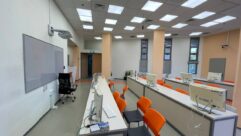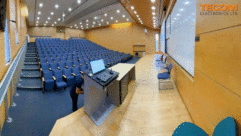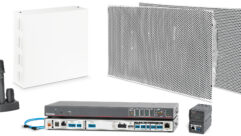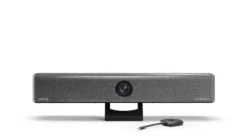
Classroom Capture
Jan 30, 2013 11:37 AM,
By Don Kreski
Automated webcasting systems are the focus of classroom upgrades.

Palo Alto University’s Director of Information Technology Dave Leavitt at the Smart Board in one of the new classrooms
Palo Alto University (PAU) is anything but average. At this private Silicone Valley institute, there are more graduate students than undergraduate students and a higher faculty-to-student ratio than on most campuses. Because the school keeps its focus tight it offers a better education in clinical psychology than many other universities can offer.
Yet there are some downsides. “Because our students all live off campus, it can be harder for them to attend every class and harder for them to seek help after hours,” explains Dave Leavitt, PAU’s director of information technology. When Leavitt and a faculty taskforce were studying ways to improve classroom technology, they decided to include lecture capture and webcasting in their new AV systems.
“We helped the university upgrade their classrooms in a number of ways,” says Murray Lewis, account executive at Beaverton, Ore.-based CompView Audio Visual. “We added Smart Boards and document cameras, and we upgraded their projection, sound, and control systems. Still, the most powerful technology we installed was lecture-capture-based on a MediaSite RL recording device from Sonic Foundry and robotic cameras from Vaddio.”

A Vaddio IR Sensor registers whether the professor is standing at the lectern. If so, it triggers a preset on the WallView PTZ camera (below) to zoom in for a shot similar to the one below; if not, it triggers a wide shot centered on the Smart Board.
Flexibility Crucial
The system design was challenging for Lewis and CompView Systems Integration Manager Phil Dusold because it wasn’t positive how the faculty would use the system. Glenn Saito, instructional designer and media specialist for the university, started a pilot program in lecture capture once the new systems were installed. Lewis and Dusold responded by including manual controls that allowed each professor to start and stop classroom recording from an Extron TLP 1000MV touchpanel mounted in the classroom lectern. If they wish, they can control camera presets and other functions from the panel.
In practice, faculty participating in Saito’s pilot have all chosen to rely on the system’s automated controls. Normally the professor and Saito schedule class recording in advance, and the system starts and stops itself automatically. A Vaddio Overhead IR sensor mounted on the ceiling registers whether or not a professor is standing at the lectern. If so, it signals a Vaddio WallView PTZ camera mounted at the back of the room to zoom in close. If the professor moves away from the lectern, the sensor signals the camera to switch to a wide shot which encompasses an 87in. Smart Multitouch Interactive whiteboard.

At the same time, the system feeds an input from either a rack-mounted PC or the professor’s laptop into the MediaSite recorder. The system records two streams from the camera and the computer system, and both automatically go to a video-on-demand server powered by MediaSite EX Server software. Students watching the streams later as a webcast will see a picture-in-picture image, or they can choose to enlarge either the professor’s image or the computer image to full screen. Since the Smart Board is essentially a computer peripheral, images it generates show up in the data window. Students can choose to watch professors writing on the board via the Vaddio camera, which is sharp enough to capture clear images of the class and what is written on the board. Students can also choose to switch to the data stream to only see the text created (or the original projected image and the markups). The webcast includes spoken and program audio of the lecture as well as any sound included with the visuals. If professors show video from a document camera, a DVD player, or VCR, the system also routes these images into the data window.
Saito says he hopes PAU faculty will use the system to expand their teaching beyond traditional methods. “We’re looking at the flipped classroom method, where we ask students to watch lectures before class, then devote class time to discussion or clinical activities,” he says. He expects that lecture capture, used in this way, has the potential to significantly improve educational outcomes.
1
Classroom Capture
Jan 30, 2013 11:37 AM,
By Don Kreski
Automated webcasting systems are the focus of classroom upgrades.

Installing the Systems
Once the decisions were made on what to install, Leavitt was surprised how quickly and smoothly the AV installation went. “From start to finish, the project took just six weeks, and that was for six classrooms on two campuses,” Leavitt says. CompView finished the install in time for fall 2011 classes, and after a year of use, Leavitt says he’s only seen minor maintenance issues. He has never had a system or system component unusable for a class.
Part of the system’s success was a forgiving design that anticipates user errors. For example, for the best possible audio, CompView included a wireless Shure lavalier mic in each classroom. If a professor forgets to use it or does not wish to, a podium mic and ceiling-mounted Shure MX202 mics will pick up his or her voice. “We installed the ceiling mics primarily to capture questions from students sitting in the classrooms, but they have this fail-safe function as well,” Lewis explains.
Building a failure-proof AV system can be somewhat more costly than one that is not, but Lewis feels it’s worthwhile. “The Vaddio camera, for example, is a better camera than others we might choose, but its extra cost is low compared to the total for the classroom system,” he says.
Leavitt says his only regret is in not installing two cameras in each classroom, with the second picking up images of the students as they participate. “That would be especially helpful now, as we’re looking at adding two-way video so that guest speakers can address our classes without having to travel to campus” he explains. Lewis, on the other hand, says accommodating this need will not be a problem. “Plans change and ideas grow once people start using new technology, but that’s OK. We build flexibility into our designs, and we can easily add another camera or a videoconferencing codec,” he says.
Leavitt believes the new systems are proving themselves every day. “Ours can be a tough curriculum and classes can be intense at times. Having the ability to review a concept as many times as you need to is a valuable resource,” he says. Leavitt adds, “The installation has been fantastic. CompView did a great job. The video is really good, the streaming is working great, and we have good buy-in and feedback from faculty and students. I’m really happy that we made this investment.”
2










